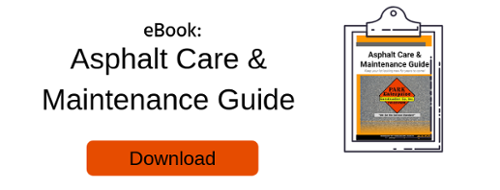
Winter is on the way, so we're not too far from snow and freezing temperatures. If you live in Ohio, you already know there's a list of things that you need to winterize around your property before winter weather hits.
And if you're a property manager, you know that winterization isn't just necessary inside your facility, but outside as well.
For instance, your asphalt parking lot is one area that you don't want to ignore when it comes to prepping it for winter. Here's a look at some of the things you should keep in mind when it comes to winterizing your asphalt.
Steps to Prepare Your Asphalt For Winter
- Inspect and clean it
- Seal cracks
- Check for low areas holding water
- Limit salting
1. Inspect and clean It
The first thing you'll want to do to winterize your lot is inspect it, making sure it's free of any leaves or debris. If debris is left to sit on pavement, it can actually start to damage the asphalt surface over time.
Cleaning it also helps ensure that water is able to drain properly in the parking lot, as leaves and other debris accumulate, it can cause damming in the lot and lead to standing water and slick surfaces, which can then freeze and cause cracks in your asphalt.
2. Seal Cracks
Have cracks in your pavement? You'll want to get them sealed before winter weather hits. That's because when water gets into the cracks and freezes, it can expand the size of cracks and cause more damage over the long term. Ideally, you'll want to make sure that no water has the opportunity to get beneath the surface of the lot.
Taking the time to seal any cracks or areas of concern can help extend the life of the asphalt and prevent potholes from forming. If you really want to amp up your efforts, consider seal coating the entire lot. This should only be performed after the lot has been cleaned and debris has been removed, and is not necessary to do annually.
ICYMI: We have an article all about sealcoat.
3. Check for Low Areas Holding Water
Over time, asphalt settles, and this can create some fluctuation in the lot. While you're prepping your lot for winter, take note of any low areas and make plans to address them.
Low or settling areas may not just be unsightly, but they can also be a sign of weak areas in the lot. Hence, having them properly repaired can help extend lot life.
4. Try to Limit Salting
Though salting may be necessary, it can also harm the surface of your lot. Conventional road salt is much more friendly to asphalt surfaces than it is to concrete. Still, if you can help it, try to limit salting by shoveling and plowing instead.
Additionally, any low areas in the lot can pose an issue to plows and lead to scraping and further damage.
How prepared is your asphalt lot for winter? Take the necessary steps now so it can look great next spring and beyond.
Looking for even more tips on the care and maintenance of your asphalt?
Check out our complete guide:




